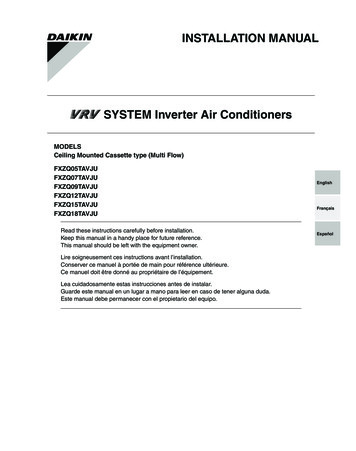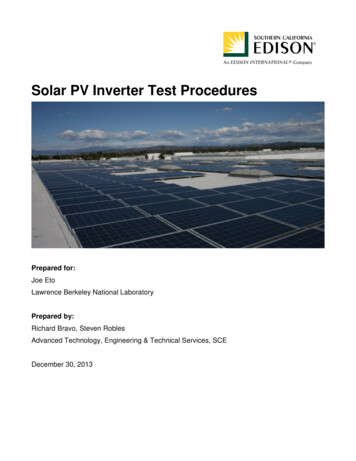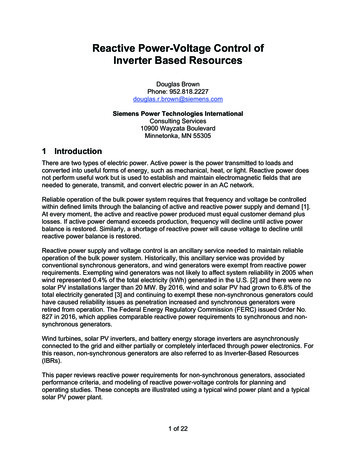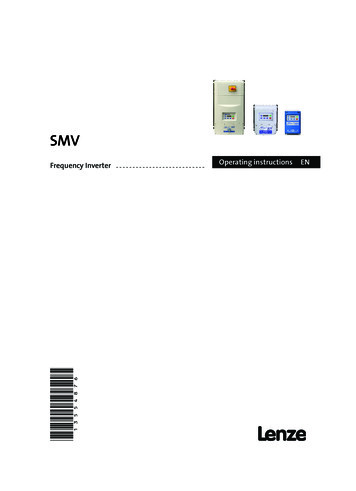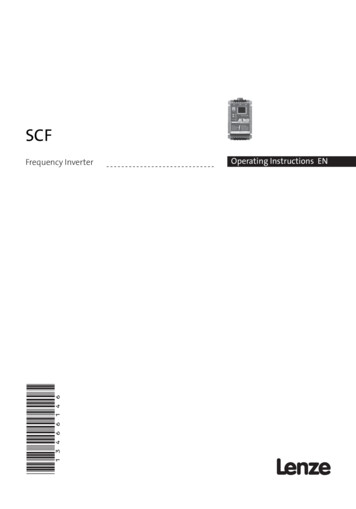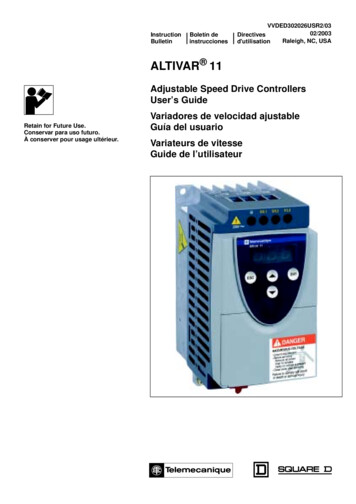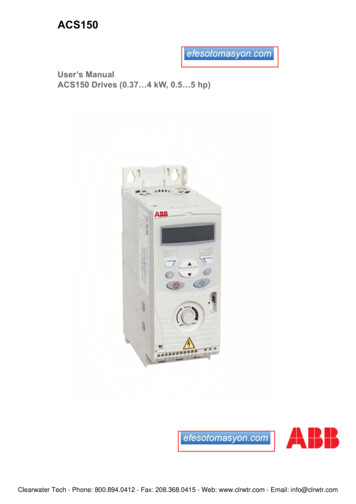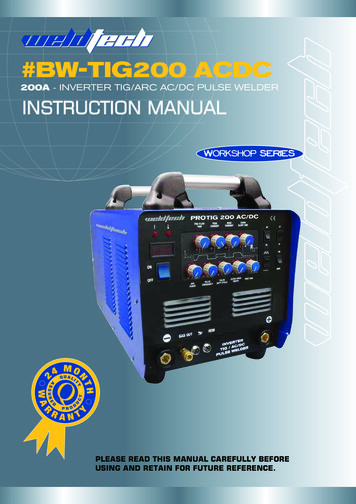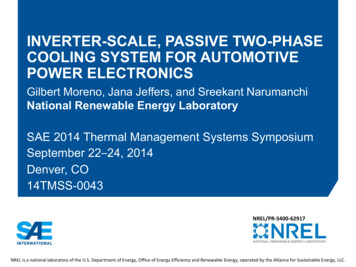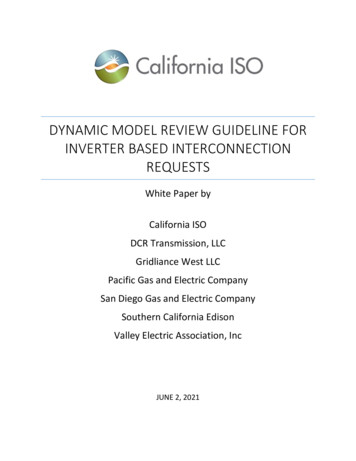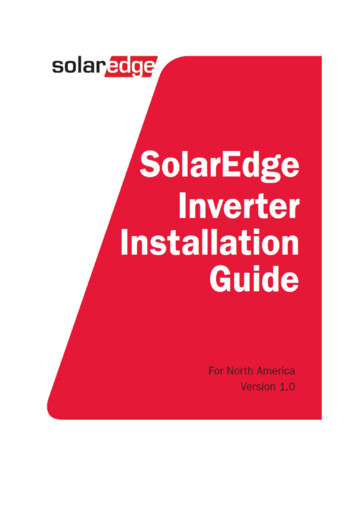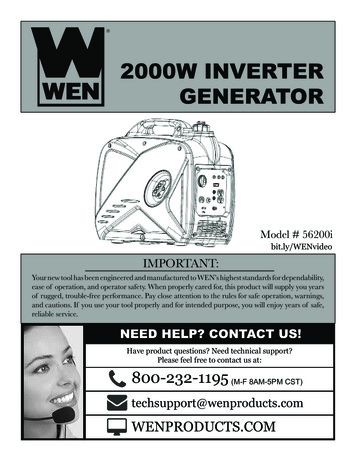
Transcription
2000W INVERTERGENERATORModel # 56200ibit.ly/WENvideoIMPORTANT:Your new tool has been engineered and manufactured to WEN’s highest standards for dependability,ease of operation, and operator safety. When properly cared for, this product will supply you yearsof rugged, trouble-free performance. Pay close attention to the rules for safe operation, warnings,and cautions. If you use your tool properly and for intended purpose, you will enjoy years of safe,reliable service.NEED HELP? CONTACT US!Have product questions? Need technical support?Please feel free to contact us at:800-232-1195 (M-F 8AM-5PM CST)techsupport@wenproducts.comWENPRODUCTS.COM
TABLE OF CONTENTSGenerator IdentificationService RecordIntroductionSafety InformationGeneral Safety ProceduresImportant Safety InstructionsGenerator ComponentsGenerator PreperationStarting the GeneratorStopping the GeneratorSubsequent Starting of the GeneratorUsing the GeneratorMaintenance & CareStorage & TransportSpecificationsTroubleshootingExploded View and Parts ListWiring DiagramWarranty Statement2334456781012121416202122232930
GENERATOR IDENTIFICATIONIf assistance for information or service is required, please contact the Customer Service Help Line by calling800-232-1195; customer will be asked to provide generator information when calling.Refer to the illustration below for the location of the serial number. Record generator information in the spacesprovided below.DATE OF PURCHASE:PURCHASED FROM:GENERATOR MODEL NUMBER:ENGINE SERIAL NUMBER:SERVICE RECORDRecord Service Dates:DateDateDateDateDateDateChange OilChange Spark PlugClean Fuel TankClean Air Cleaner3
INTRODUCTIONThank You for Purchasing a WEN Product. This manual provides information regarding the safe operationand maintenance of this product. Every effort has been made to ensure the accuracy of the information in thismanual. WEN reserves the right to change this product and specifications at any time without prior notice.Please keep this manual available to all users during the entire life of the generator.This manual contains special messages to bring attention to potential safety concerns, generator damage as well as helpful operating and servicing information. Please read all theinformation carefully to avoid injury and machine damage.QUESTIONS? PROBLEMS?In order to answer questions and solve problems in the most efficient and speedy manner, contact CustomerService at (800) 232-1195, M-F 8-5 CSTNOTICE REGARDING EMISSIONSEngines that are certified to comply with U.S. EPA emission regulations for SORE (Small Off Road Equipment),are certified to operate on regular unleaded gasoline, and may include the following emission control systems:(EM) Engine Modifications and (TWC) Three-Way Catalyst (if so equipped).SAFETY INFORMATIONBefore operating this generator read and observe all warnings, cautions, and instructions on the generator and inthis Owner’s Manual.NOTE: The following safety information is not meant to cover all possible conditions and situations that may occur. Read the entire Owner’s Manual for safety and operating instructions. Failure to follow instructions and safetyinformation could result in serious injury or death.This safety alert symbol is used to identify safety information about hazards that can result in personal injury.A signal word (DANGER, WARNING, or CAUTION) is used with the alert symbol to indicate thelikelihood and the potential severity of injury. In addition, a hazard symbol may be used to representthe type of hazard.DANGER indicates a hazard, which, if not avoided, will result in death or serious injury.WARNING indicates a hazard, which, if not avoided, could result in death or serious injury.CAUTION indicates a hazard, which, if not avoided, might result in minor or moderate injury.CAUTION when used without the alert symbol, indicates a situation that could result in damage to the engine orgenerator.4
GENERAL SAFETY PROCEDURESFor any questions regarding the hazard and safety notices listed in this manual or on the product, please call (800)232-1195 M-F 8-5 CST before using the generator.DANGER: CARBON MONOXIDEUsing a generator indoors CAN KILL YOU IN MINUTES. Generator exhaust contains carbon monoxide (CO).This is a poison gas you cannot see or smell. If you can smell the generator exhaust, you are breathing CO. Buteven if you cannot smell the exhaust, you could be breathing CO.NEVER use a generator inside homes, garages, crawlspaces, or other partly enclosed areas. Deadly levelsof carbon monoxide can build up in these areas. Using a fan or opening windows and doors does NOTsupply enough fresh air. ONLY use a generator outside and far away from windows, doors, and vents. These openings can pull in generator exhaust.Even if you use a generator correctly, CO may leak into the home. ALWAYS use a battery-powered or batterybackup CO alarm in the home. If you start to feel sick, dizzy, or weak after the generator has been running, moveto fresh air RIGHT AWAY. See a doctor. You may have carbon monoxide poisoning.WARNING: The exhaust from this product contains chemicals known to the State of California to causecancer, birth defects, or other reproductive harm.WARNING: This generator may emit highly flammable and explosive gasoline vapors, which can causesevere burns or even death if ignited. A nearby open flame can lead to explosion even if it isn’t directly incontact with gasoline. Do not operate near open flame. Do not smoke near generator. Always operate on a firm, level surface. Always turn generator off before refueling. Allow generator to cool for at least 2 minutes before removingfuel cap. Loosen cap slowly to relieve pressure in tank. Do not overfill fuel tank. Gasoline may expand during operation. Do not fill to the top of the tank. Allowfor expansion. Always check for spilled fuel before operating. Empty fuel tank before storing or transporting the generator.WARNING: This generator produces powerful voltage, which can result in electrocution. ALWAYS ground the generator before using it (see the “Ground the Generator” portion of the“GENERATOR PREPARATION” section). Generator should only be plugged into electrical devices, either directly or with an extension cord.NEVER connect to a building electrical system without a qualified electrician. Such connections mustcomply with local electrical laws and codes. Failure to comply can create a back-feed, which may resultin serious injury or death to utility workers. Use a ground fault circuit interrupter (GFCI) in highly conductive areas such as metal decking or steelwork. GFCIs are available in-line with some extension cords. Do not use in rainy conditions. Do not touch bare wires or receptacles (outlets). Do not allow children or non-qualified persons to operate.5
GENERAL SAFETY PROCEDURESWARNING: This generator produces heat when running. Temperatures near exhaust can exceed 1500F (650 C).Do not touch hot surfaces. Pay attention to warning labels on the generator identifying hot parts of themachine.Allow generator to cool down after use before touching engine or areas of the generator that becomehot during use.CAUTION: Misuse of this generator can damage it or shorten its life.Only use generator for its intended purposes.Operate only on dry, level surfaces.Allow generator to run for several minutes before connecting electrical devices.Shut off and disconnect any malfunctioning devices from generator.Do not exceed the wattage capacity of the generator by plugging in more electrical devices than the unit canhandle.Do not turn on electrical devices until after they are connected to the generator.Turn off all connected electrical devices before stopping the generator.Turn the engine switch to “OFF” position when the engine is not running.IMPORTANT SAFETY INSTRUCTIONSSAVE THESE INSTRUCTIONS – This manual contains important instructions for the WEN 2000W invertergenerator that should be followed during installation and maintenance of the generator.Generators vibrate in normal use. During and after the use of the generator, inspect botht he generator as well asextension and power supply cords for damage resulting from vibration. Have damaged items repaired or replacedas necessary. Do not use plugs or cords that show signs of damage such as broken or cracked insulation or damaged blades.For power outages, permanently installed stationary generators are better suited for providing backup power to thehome. Even a properly connected portable generator can become overloaded. This may result in overheating orstressing of the components, possibly leading to a generator failure.WARNING: If this generator is used as a supply for a building’s wiring system, the generator must be installedby a qualified electrician and connected to a transfer switch as a separately derived system in accordance withthe National Electrical Code, NFPA 70. The generator shall be connected to a transfer switch that switches allconductors excluding the equipment grounding conductor. The frame of the generator shall be connected to anapproved grounding electrode.6
GENERATOR COMPONENTSUse the illustrations below to become familiar with the locations and functions of the various components andcontrols of this generator.Fuel CapVacuum Relief Valve3-in-1 SwitchRecoil StarterIdle Switch120V Duplex ReceptacleCircuit BreakerGrounding Nut12V DC OutletUSB Charger7
GENERATOR PREPARATIONUSING THE GENERATOR FOR THE FIRST TIMEThe following section describes steps necessary to prepare the generator for use. If after reading this section, you are unsure about how to perform any of the steps please call (800) 232-1195 M-F 8-5 CST forcustomer service. Failure to perform these steps properly can damage the generator or shorten its life.Step 1 - ADD OILThe generator is shipped without oil. User must add the proper amount of oil before operating the generator forthe first time. The oil capacity of the engine crankcase is 0.37 quarts (0.35 liters). For general use (above 40 F),we recommend 30W, 4-stroke engine oil.ENGINE OIL RECOMMENDATIONSSelect good quality detergent oil bearing the American Petroleum Institute (API) service classifications SJ, SL,or SM. (Synthetic oils may be used.) Use the ASE viscosity grade of oil from the following chart (Figure 1) thatmatches the starting temperature anticipated before the next oil changes.Figure 1 - Engine Oil ReplacemendationsTo add oil, follow these steps:1. Make sure the generator is on a level surface. Tilting the generator to assist in filling will cause oil to flowinto engine areas and will cause damage. Keep generator level!2. Open the access panel. Remove the dipstick from the engine. (Figure 2)3. Add oil slowly to bring level to full. (Figure 2).4. To check the oil level: wipe the dipstick with a clean rag. Insert the dipstick into the oil fill openingwithout screwing in. Remove the dipstick to check the oil mark.5. Slowly add more oil and repeat step 4 until the oil mark reaches to the top of the dipstick (Figure 2). Donot over fill the crankcase. The generator is equipped with a low oil sensor and will not start if the amountof oil is in sufficient.6. Check for oil leaks. Tighten dipstick firmly before closing the access panel.Oil Dipstick8Figure 2 - Oil Fill Opening, Dipstick and Oil Level
GENERATOR PREPARATIONStep 2 - ADD GASOLINEWARNING: This generator may emit highly flammable and explosive gasoline vapors,which can cause severe burns or even death if ignited. A nearby open flame can lead toexplosion even if not directly in contact with gasoline.Use fresh (within 30 days from purchase), lead-free gasoline with a minimum of 87 octane rating. Do not mix oilwith gasoline.To add gasoline, follow these steps:1. Make sure the generator is on a level surface.2. Unscrew fuel cap and set aside. NOTE: The fuel cap may be tight and hard to unscrew.3. Slowly add unleaded gasoline to the fuel tank. Be careful not to overfill. The capacity of the fuel tank is 1gallon. NOTE: Do not fill the fuel tank to the very top. Gasoline will expand and spill over during use evenwith the fuel cap in place.4. Reinstall fuel cap and wipe clean any spilled gasoline with a dry cloth.IMPORTANT: Never use an oil/gasoline mixture. Never use old gasoline. Avoid getting dirt or water into the fuel tank. Gasoline can age in the tank and make starting difficult. Never store generator for extended periods of timewith fuel in the tank.Step 3 - GROUND THE GENERATORWARNING: Failure to properly ground the generatorcan result in electrocution.Ground the generator by tightening the grounding nut on thefront control panel against a grounding wire (Figure 3). A generally acceptable grounding wire is a No. 12 AWG (American WireGauge) stranded copper wire. This grounding wire should beconnected at the other end to a copper, brass, or steel-groundingrod that is driven into the earth. Wire and grounding rods are notincluded in generator contents.Grounding codes can vary by location. Contact a local electricianto check the area codes.Figure 3 - Grounding NutNOTE: After completing the above preparation, the generator is ready to be started.9
STARTING THE GENERATORBefore starting the generator, make sure you have read and performed the steps in the “Generator Preperation”section of this manual. If you are unsure about how to perform any of the steps in this manual please call (800)232-1195 M-F 8-5 CST for customer service.DANGER: CARBON MONOXIDE.Using a generator indoors CAN KILL YOU IN MINUTES.Generator exhaust contains carbon monoxide (CO). This is a poison gas you cannot see or smell. If you cansmell the generator exhaust, you are breathing CO. Even if you cannot smell the exhaust, you may be breathing CO.NEVER use a generator inside homes, garages, crawlspaces, or other partly enclosed areas. Deadly levels ofcarbon monoxide can build up in these areas. Using a fan or opening windows and doors does NOT supplyenough fresh air.ONLY use a generator
likelihood and the potential severity of injury. In addition, a hazard symbol may be used to represent the type of hazard. DANGER indicates a hazard, which, if not avoided, will result in death or serious injury. WARNING indicates a hazard, which, if not avoided, could result in death or serious injury. CAUTION indicates a hazard, which, if not avoided, might result in minor or moderate injury .
